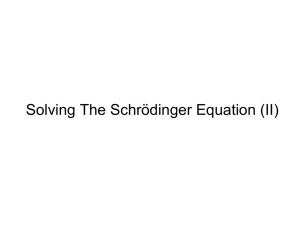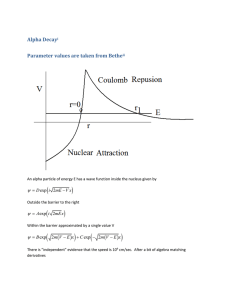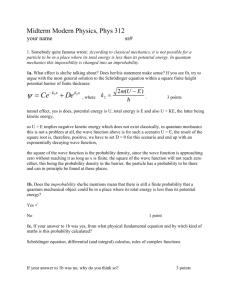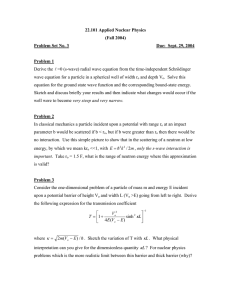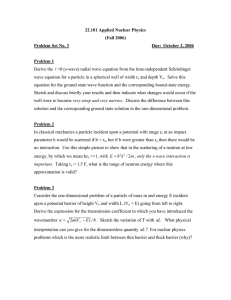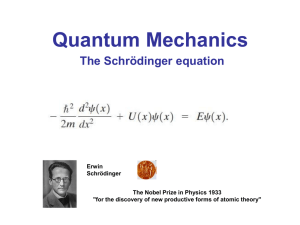Quantum Tunneling One of the mysteries of quantum mechanics
advertisement
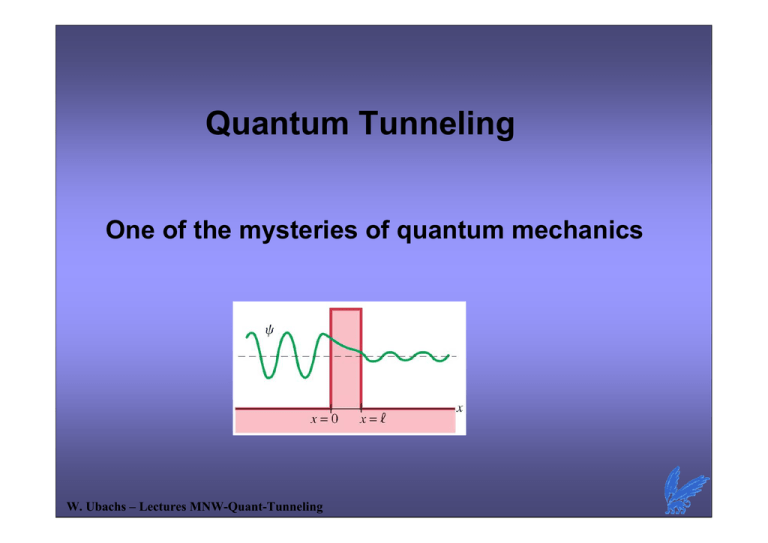
Quantum Tunneling One of the mysteries of quantum mechanics W. Ubachs – Lectures MNW-Quant-Tunneling Finite Potential Well A finite potential well has a potential of zero between x = 0 and x = l , but outside that range the potential is a constant U0. The potential outside the well is no longer zero; it falls off exponentially. Solve in regions I, II, and III and use for boundary conditions Continuity: ψ I (0) = ψ II (0) dψ I dψ II ( 0) = (0) dx dx ψ II (l) = ψ III (l) dψ II dψ III (l ) = (l ) dx dx Bound states: E < E0 Continuum states: E > E0 Finite Potential Well If E < U0 in the “forbidden regions” ⎡ 2m(U 0 − E )⎤ − ⎥⎦ψ = 0 dx 2 ⎢⎣ h2 d 2ψ General solution: Region I x<0 ψ I = CeGx hence D=0 should match Finite value at x=0 with G2 = 2m(U 0 − E ) h2 ψ I , III = CeGx + De −Gx and similarly for C ψ II = A sin kx + B cos kx exponentially decaying into the finite walls Finite Potential Well These graphs show the wave functions and probability distributions for the first three energy states. Nonclassical effects Partile can exist in the forbidden region Finite Potential Well If E > U0 free particle condition ⎡ 2 m( E − U 0 ) ⎤ + ψ =0 ⎢ ⎥ 2 2 ⎣ ⎦ dx h d 2ψ d 2ψ ⎡ 2mE ⎤ + ψ =0 ⎢ 2 2 ⎥ ⎣ h ⎦ dx In regions I and III In region II In both cases oscillating free partcile wave function: I,III: λ= h h = p 2 m( E − U 0 ) II: λ= h h = p 2mE 1 2 p2 E = mv + U 0 = + U0 2 2m Tunneling Through a Barrier In region x<0 oscillating wave d 2ψ λ= ⎡ 2mE ⎤ + ψ =0 ⎢ 2 2 ⎥ ⎣ h ⎦ dx Also in region h h = p 2mE x>l Wave with same wavelength λ= h h = p 2mE In the barrier: ⎡ 2m(U 0 − E )⎤ − ψ =0 ⎢ ⎥ 2 2 ⎣ ⎦ h dx d 2ψ ψ b = CeGx + De −Gx Approximation: assume that the decaying function is dominant ψ = De −Gx b Transmission: T = ψ (x = l) ψ (x = 0) 2 2 2 ( De −Gx ) = = e − 2Gl D2 Tunneling Through a Barrier The probability that a particle tunnels through a barrier can be expressed as a transmission coefficient, T, and a reflection coefficient, R (where T + R = 1). If T is small, T ≈ e − 2Gl G= 2m(U 0 − E ) h2 The smaller E is with respect to U0, the smaller the probability that the particle will tunnel through the barrier.
